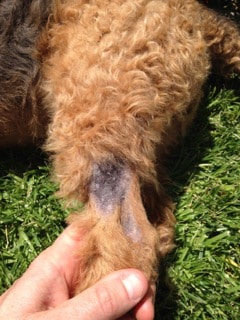Unexpected Side Effects of Chemotherapy Treatment
For nearly five months now, my dog Cardiff has been undergoing chemotherapy treatment for lymphoma. Cardiff’s single known site of lymphoma affected a loop of small intestine and was surgically removed in early December 2013. After healing from his surgery, Cardiff started chemotherapy and has tolerated his treatments very well while showing few side effects.
Cardiff is on a chemotherapy protocol called CHOP, which is also known as the University of Wisconsin-Madison Canine Lymphoma Protocol. CHOP is an acronym for Cyclophosphamide, Hydroxyadaunorubucin (Doxorubicin), Oncovin (Vincristine), and Prednisone. Cardiff received oral or injectable chemotherapy on an every seven day basis for 10 weeks and now is on an every 14 day interval for the remainder of his 24 weeks of treatment. As a pet owner, I am very relieved to see my pooch feeling better, eating more normally, and in general acting more like the energetic terrier he has been for so much of his nearly nine years of life.
One of the injectable drugs Cardiff receives is Vincristine. It’s an agent that causes alkylation, which damages the DNA of both cancerous and non-cancerous cells. Vincristine is given intravenously (directly into the vein). Cardiff’s injections are given by skilled veterinary technicians who are extremely familiar with the administration of such drugs (as they do so day in and day out).
Of course, not everything can always go perfectly and Cardiff recently suffered a side effect of his chemotherapy that was worse than the commonly anticipated digestive tract upset.
Two days after Cardiff received a Vincristine injection he developed lameness in the limb where the injection was given in the lateral saphenous vein (the vessel on the outside of the ankle at the level of the Achilles [calcanean] tendon). Although there were no reports of any problems with the injection’s infusion, Cardiff was showing signs that some of the drug had made its way out of his vein into the surrounding tissue.
The lymph node hidden in the muscle behind his knee (the popliteal lymph node), which lies just above the injection site, was not swollen, but he had swelling from the site of injection and up his limb to the point of his hip. Cardiff exhibited shifting leg lameness and also couldn’t comfortably bend his left hindlimb to sit or lie down. Additionally, he started licking at the affected site in a manner showing he was bothered by an abnormality at the site.
After consulting with his veterinary oncologist (Dr. Mary Davis from Veterinary Cancer Group) and multiple veterinary technicians who are more familiar with Vincristine's administration then me, the assessment was made that some of the drug leaked out of his vein.
According to Veterinary Partner, “Vincristine is highly irritating to the soft tissues and if it is not given intravenously, where the bloodstream rapidly carries it away and dilutes it within the body’s blood volume, it will cause what is called a tissue slough. This means the soft tissues will die and fall away, leaving a large sore. Unlike the tissue sloughs of doxorubicin, a vincristine slough will eventually heal but it will require bandaging and be a source of discomfort.”
Fortunately for Cardiff, he did not show an extreme extent of potential tissue damage caused by Vincristine’s leakage from his blood vessel.
The recommended treatment was to warm compress the affected sites, as promoting blood flow to the areas of tissue damage helps remove byproducts of tissue damage and delivers oxygen and nutrients to the site. I elected to enhance such treatment by providing cold laser therapy with my trusty Multi Radiance Medical MR4 ACTIVet laser. Cardiff received two treatments over a period of 48 hours and the limb’s swelling nearly resolved. I also did extensive passive range of motion (PROM), acupressure massage, and whole body acupuncture treatment. Within another 48 hours, the swelling and discomfort had resolved.
Approximately two weeks later, Cardiff developed a sudden loss of hair at the site paired with dark pigment and mild superficial crusting. Further laser treatment and gentle superficial cleansing with MalAcetic wipes helped to stabilize the issue. As the chemotherapy treatments become less frequent, Cardiff’s hair has been growing more normally. It’s nice to see his healthy, rich-auburn colored coat reappear at his left ankle.
From now on, we are using a different limb and vein to administer his injectable chemo and keeping a close eye out for the development of potential injection-site side effects. Hopefully, Cardiff will continue to thrive and his lymphoma will stay in remission even after we complete his chemotherapy course.

Tissue slough from the Vincristine injection, with resulting irritation and hair loss.

Cardiff showing challenge in bending his left hind limb, but he’s still “hanging loose!"

Dr. Patrick Mahaney
Image: Cardiff in the high grass
Related articles:
